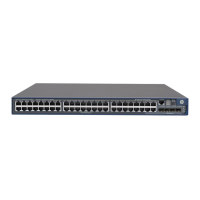151
If any condition is not satisfied, the device re-authenticates the user on the new port.
Use the undo portal move-mode command to disable support for portal user moving.
By default, support for portal user moving is disabled, and if an authenticated user moves from a port of
the device to another port of the device without logging off, the user cannot get online when the original
port is still up, because the original port is still maintaining the authentication information of the user.
If the original port goes down after a user moves from the port to another port, the authentication
information of the user is lost and the user has to be re-authenticated.
Support for portal user moving applies to scenarios where hubs, Layer 2 switches, or APs exist between
users and the access devices.
Examples
# Enable support for portal user moving.
<Sysname> system-view
[Sysname] portal move-mode auto
portal nas-id-profile (available only on the A5500 EI)
Syntax
portal nas-id-profile profile-name
undo portal nas-id-profile
View
Interface
Default level
2: System level
Parameters
profile-name: Specifies the name of the profile that defines the binding relationship between VLANs and
NAS IDs. The profile can be configured by using the aaa nas-id profile command. For more information
about this command, see the chapter ―AAA configuration commands.‖
Description
Use the portal nas-id-profile command to specify a NAS ID profile for the interface.
Use the undo portal nas-id-profile command to cancel the configuration.
By default, an interface is not specified with any NAS ID profile.
If an interface is specified with a NAS ID profile, the interface will prefer to use the binding defined in the
profile. If no NAS ID profile is specified for an interface or no matching binding is found in the specified
profile, it will use the device name as the interface NAS ID.
Examples
# Specify NAS ID profile aaa for VLAN-interface 2.
<Sysname> system-view
[Sysname] interface vlan-interface 2
[Sysname-Vlan-interface2] portal nas-id-profile aaa

